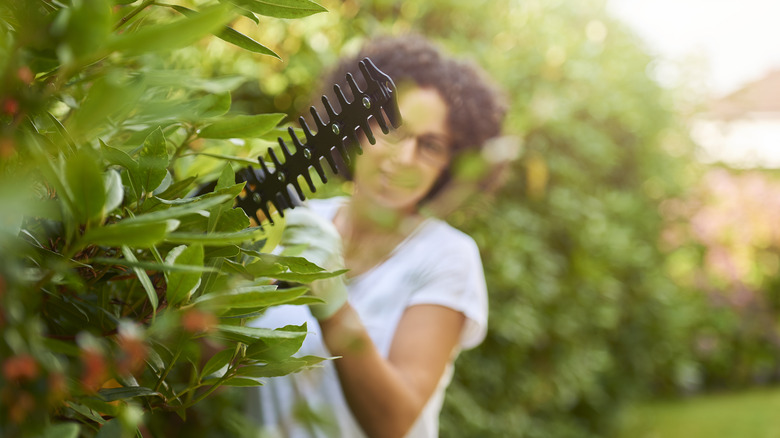The Best Method For Sharpening Your Hedge Trimmers
Like any other blade, hedge trimmers lose their bite in the course of continued use. Sawing through branches on a regular basis, or even using your hedge trimmers to trim overgrown grass, wears the cutting edges of the blades down over time, and they become dull and ineffective. You'll know your hedge trimmers should be sharpened if the edges it leaves on branches aren't even, or if it's struggling to make the cuts at all. Fortunately, you don't need any expensive or specialized tools or techniques to sharpen the hedge trimmer blades. All you need is some safety gear, a stable working surface, a vise, a flat file, a whetstone, some cloths, and a lubricant like WD-40.
The best method for sharpening hedge trimmers is to start with a flat file, which should remove major dents and make the blades sharp again. Then, you finish the job with a whetstone. The whetstone helps remove minor imperfections caused by the flat file. With the two-step sharpening process complete, all you need to do is treat the blades with an anti-corrosion spray and you're good to go! Since you're dealing with a powered landscaping tool, safety is paramount, and you should use protective goggles and gloves to avoid injury during the sharpening process. We walk you through the complete sharpening steps below.
Steps for sharpening hedge trimmers properly
First, secure your hedge trimmer with a vise on an even, stable surface, and make sure that it can't accidentally start by taking out the battery. Then clean the blades thoroughly with a cloth. During use, hedge trimmers are in constant contact with stems, leaves, and branches, and over time, sap, resin, and plant fibers can build up on the blades. All this grime should be gone from the blades before you begin sharpening.
Once the blades are clean, start sharpening each of the blades using the flat file. Drag the file across each blade in the direction of the cutting edge (never going back and forth), holding it at a roughly 30-degree angle. Each time you complete a forward stroke with the file, lift it off the blade to bring it back. The strokes should be firm but not too aggressive, and you should stroke each blade with the file the exact same number of times.
After you've taken the file to each of the hedge trimmer's blades, it's time to change your sharpening tool to the whetstone. Begin by turning the hedge trimmer over; the whetstone procedure is meant to treat the other side of the blades. Next, wipe the blades with a water-soaked cloth to make them wet, and begin sharpening with the whetstone. The movements should be similar to those you make with the file, as you drag the stone in the direction of the cutting edge. Once you've worked over every blade with the whetstone, lubricate the blade with a lightweight machine oil — WD-40 is a good choice for this application. If you're not sure how to use this lubricant properly, check out our tips for using WD-40 around the house.
